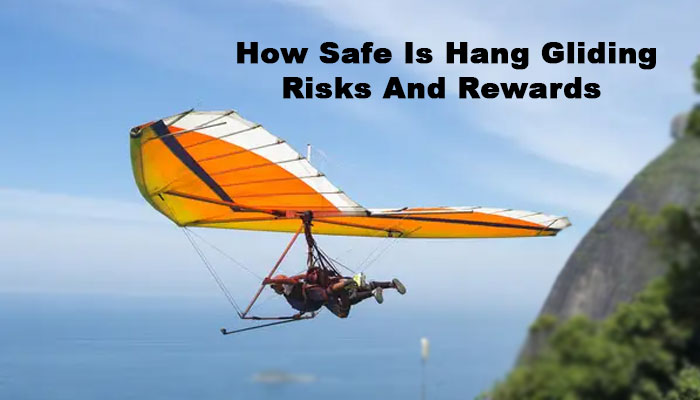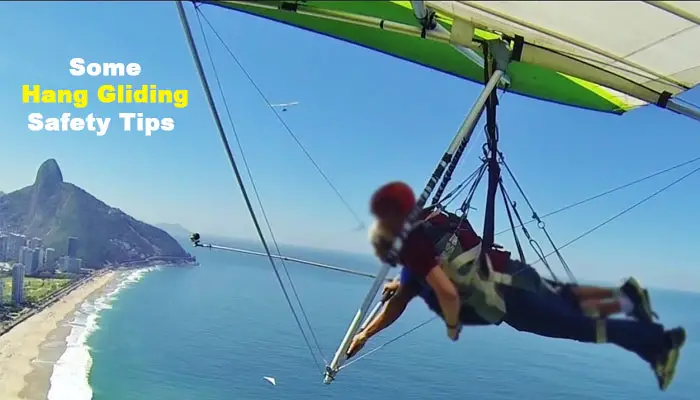How Safe Is Hang Gliding? Risks and Rewards
- By Infoik
- 03 Oct, 2022

How safe is hang gliding?
Hang gliding is inherently risky, and accidents can and do happen. However, most hang gliding accidents are preventable, and pilot errors cause many.
The best way to stay safe while hanging gliding is to receive proper instruction and training from a certified instructor and to always fly with a licensed and insured pilot.
The Most Dangerous Things About Hang Gliding

Three main things make hang gliding dangerous: the height, the speed, and the turbulence. The height makes it dangerous because you could fall a long way and get seriously injured if something goes wrong. The speed is also dangerous because if you hit something, it could be awful. And the turbulence can make it difficult to control your glider, leading to accidents.
Is hang gliding or paragliding safer
It depends on many factors, including the experience of the hang glider pilot, the weather conditions, and the type of equipment being used. Generally, hang gliding is considered slightly safer than paragliding because it is more stable in flight, and pilots have more control over the aircraft. However, both activities carry a certain amount of risk.
Hang Gliding vs. Paragliding
A few key differences between hang gliding and paragliding affect how safe each activity is. For one, hang gliding requires a launch assist, typically from a winch or a tow plane. This means that an additional mechanical component can fail, which increases the chance of an accident. Secondly, hang gliders typically fly much higher than paragliders, which means that if something goes wrong, the consequences are typically more severe. Finally, hang gliders have a much smaller margin for error when landing, as they need to land in an open area without any obstacles.
Some Hang Gliding Safety Tips

Hang gliding is an inherently dangerous sport. So many things can go wrong while you’re up in the air, and even the most experienced pilots are not immune to accidents. Below is the list of the most common accidents in hang gliding and some tips on how to avoid them:
- Stalls: A stall happens when the airspeed drops too low, and the wing can no longer generate lift. To avoid stalls, ensure you understand how your wing works and always keep an eye on your airspeed.
- Collisions: Collisions are probably the most dangerous thing that can happen while you’re hang gliding. To avoid collisions, always be aware of where other pilots are and give them plenty of space.
- Thermals: Thermals are updrafts of warm air that can lift you unexpectedly. To avoid thermals, avoid areas with a lot of sun exposure, such as open fields or cliffs.
- Wind Shear: Wind shear is when the wind speed changes suddenly and can cause your wing to collapse. To avoid wind shear, always be aware of the weather conditions and avoid flying in strong winds.
With any dangerous sport, there is always some risk involved. However, if you follow the safety tips above, you can minimize the risks and have a great time hanging gliding!
FAQs:
Are hang gliding accidents common?
No, hang gliding accidents are relatively rare. However, they can happen; when they do, they are often severe or even fatal.
Is hang gliding safer than skydiving?
Yes, hang gliding is generally considered to be safer than skydiving. This is because hang gliders have more control over their aircraft and can stay in the air for extended periods.
Do Hang gliders wear parachutes?
Yes, most hang gliders wear parachutes. It is required by law in many countries. Wearing a parachute gives the pilot a better chance of surviving if something goes wrong.
Which is safer, hang gliding or paragliding?
It depends on many factors, including the experience of the pilot, the weather conditions, and the type of equipment being used. Generally, hang gliding is considered slightly safer than paragliding because it is more stable in flight, and pilots have more control over the aircraft. However, both activities carry a certain amount of risk.
How many hang gliding deaths per year?
The consensus is that the number of hang gliding deaths per year is between 30 and 50. However, this number is difficult to verify because not all accidents are reported.
Why do gliders crash?
There are several reasons gliders might crash, including pilot error, mechanical failure, and bad weather conditions.
What is the death rate for paragliding?
The death rate for paragliding is challenging to determine because not all accident rates are reported.
How hard is hang gliding?
Hang gliding is not particularly difficult, but it does require some training and practice. Nevertheless, most people who take up the sport can solo within a few weeks.
How expensive is a hang glider?
Hang gliders can range in price from a few hundred dollars to several thousand, depending on the type of glider and the features you want.
What is the weight limit for paragliding?
The weight limit for paragliding is typically between 85 and 95 kg.
Final Words: how safe is hang gliding?
Hang gliding is a relatively safe activity, but there is always a specific risk involved. The best way to stay safe while hanging gliding is to be well-trained and experienced and to always check the weather conditions before flying. Wearing a parachute is also strongly recommended.












